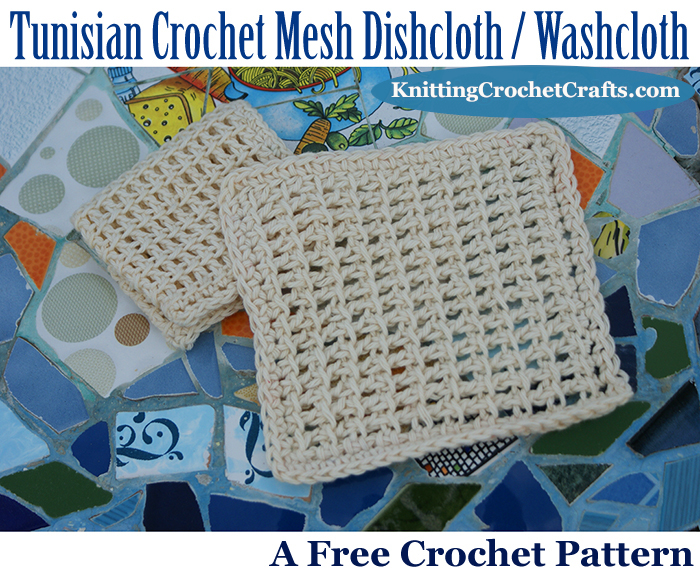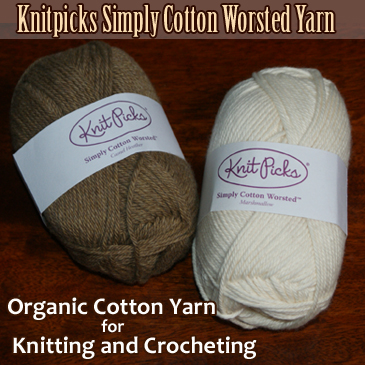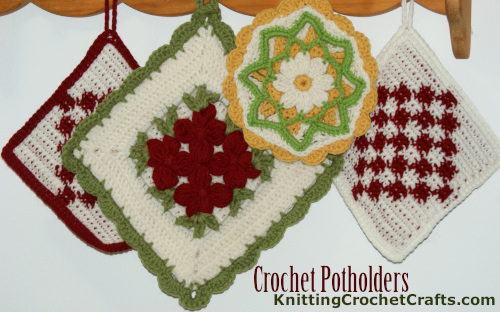
See More About: Dishcloth and Washcloth Patterns | Kitchen Crafts | Home Decor Crafts and DIY Projects | Tunisian Crochet Stitches
Are you in need of a new pattern for crocheting dishcloths or washcloths? Would you like to try making your new cloths using the Tunisian crochet technique? If so, I invite you to check out this lovely, FREE Tunisian crochet mesh dishcloth and washcloth pattern.
This pattern gives you two versions of the dishcloth / washcloth to try:
- A heavier, thicker dishcloth crocheted in worsted-weight cotton;
- And a thinner, lighter weight dishcloth crocheted in sport-weight cotton.
You can see both versions in the picture above.
I think you’re going to be delighted with these crochet projects.
Why?
For starters, the Tunisian crochet mesh stitch is easy. Once you’ve learned the stitch – which doesn’t take long – you won’t have to make much of an investment of brainpower in working these projects. You can kind of just put your brain on autopilot and crank them out. Of course, there is no such thing as a crochet project that works itself. But if you’ve ever wished there were such a thing, this is about as close as you can get to that.
Another thing: This stitch is fast. Once you’ve mastered it, it will practically fly right off your hook. Gotta love that!
And another thing: If you use the suggested yarn (which is Knit Picks’ Simply Cotton), it will be a pleasurable crochet experience. The yarn is sooooo delightfully soft, squishy and wonderful to crochet with. I ADORE this yarn.
Of course, you aren’t required to use this yarn. Feel free to substitute another yarn if you happen to have something else in mind that would work as well.
So here’s the deal: What we have here is basically two versions of the same project. The main difference between the two versions is the weight of the yarn you use for crocheting. You have the choice to make it in either worsted weight or sport weight yarn. The worsted weight version is the fastest; it works up much more quickly than the sport weight version. But, there are good reasons you might want to make either version. The choice is yours!
Skill Level: Easy
Materials:

Yarn: Knitpicks Simply Cotton (Click here to shop for this yarn at Knitpicks).
For the sport weight dishcloth, you’ll need a size H / 8 / 5.0 mm Afghan hook that measures at least 10 inches (25 cm) long. You’ll also need a traditional crochet hook for working the edging. It might require some trial and error for you to find exactly the right size traditional hook for this. Most crocheters will probably get good results with either an F / 4.0 mm or G / 4.5 mm hook.
For the worsted weight dishcloth, you’ll need a size J / 10 / 6.0 mm Afghan hook that measures at least 10 inches (25 cm) long. You’ll also need a traditional crochet hook for working the edging. It might require some trial and error for you to find exactly the right size traditional hook for this. Most crocheters will probably get good results with either an H / 5.0 mm or I / 5.5 mm hook.
Other: Tapestry needle for weaving in ends
Gauge:
It is not crucial for you to match my gauge for this project, because a dishcloth or washcloth will be useful no matter what size it turns out. However, once you’ve crocheted a few inches of your project, take a careful look at its width and make sure you’re satisfied with how it’s turning out. If it looks too wide to you, you can start over with a smaller crochet hook.
If it’s looking too narrow to you, it isn’t necessarily worth it to start over – because, when you’re finishing the project, you could simply repeat round 2 of the edging as many times as it takes to achieve a big enough dishcloth / washcloth.
Finished Size:
My worsted weight dishcloth sample measures about 6 inches square.
My sport weight dishcloth sample measures about 7 inches square.
It’s totally fine if the finished sizes of your dishcloths and washcloths vary from these dimensions. Just verify that your projects are a satisfactory size for achieving their intended purposes, and that’s really all that matters. Do keep in mind that your dishcloths and washcloths may shrink a bit when you launder them – particularly in the lengthwise direction.
Special Stitches You Will Need for Crocheting This Dishcloth / Washcloth
This dishcloth is worked in Tunisian crochet mesh stitch, which is an easy variation of afghan stitch. If you haven’t yet learned the afghan stitch, you can click here for free, step-by-step afghan stitch instructions.
Crochet Abbreviations List
- ch = chain
- ch-2 sp = chain-2 space, a space in the work you created when you worked 2 chain stitches in the round below.
- ea = each
- foll = follows
- rep = repeat
- sc = single crochet
- sl st = slip stitch
- st = stitch
- YOHFBTF = Yarn over hook from back to front – wrap your yarn over your crochet hook; it’ll start in the back, and you’ll wrap it over and around to the front, and then keep on wrapping it under your hook ’til it gets to the back again, and then you’ll just leave it there and keep crocheting the next stitch.
How to Crochet the Dishcloth / Washcloth:
For the worsted weight version of the dishcloth, ch 21. For the sport weight version, ch 31.
Work in Tunisian crochet mesh stitch as foll:
Row 1: Work a row of standard afghan stitch by pulling up a loop in ea vertical bar across the row. Then ch 1 and complete the standard return pass as foll: *Wrap the yarn over your hook and pull it through 2 loops.* Rep the sequence between *s, consolidating loops 2 at a time until you have one loop remaining on your hook.
Rows 2 and Up: The active loop on your hook counts as the first st; skip the first vertical bar, which is directly below your active loop. Work 1 afghan st in the next vertical bar. [YOHFBTF, skip next vertical bar, work 1 afghan st in next vertical bar.] Rep the sequence in brackets all the way across the row. The last st in the row will be an afghan st worked in the last vertical bar.
Ch 1 and work the standard Tunisian crochet return pass, consolidating loops 2 at a time until only 1 loop remains on your hook.
Rep row 2 until your piece is a square. My worsted weight sample dishcloth is 15 rows. My sport weight sample dishcloth is 23 rows. To achieve a perfect square, your project may need to be a different number of rows due to differences in individual crochet work. Don’t sweat it if you can’t get an exact square; you can block it square at the end.
Last Row: Work 1 sl st in ea st across, including both the afghan sts and the YOHFBTF s.
Dishcloth / Washcloth Edging
The edging for this project consists of evenly spaced sc sts all around the outer edge of the piece, connected by ch sts in the corners.
Edging Round 1: Ch 1 and rotate the work so you will be placing your sts into the edges of the rows you’ve already crocheted. Work 1 sc st into ea row edge, all the way across. When you get to the corner, ch 2 and then continue working sc, placing 1 sc in ea ch st across your foundation ch. When you get to the corner, ch 2 and then resume working in the established pattern until you’ve completed the round. Then sl st to join the end of the round to the beg.
My sample dishcloths are each finished with only one round of this edging. If you want your cloths to look just like mine, end off here and weave in your loose ends. But if you want to make your project slightly bigger, feel free to proceed to round 2 below. You can repeat round 2 as many times as necessary to achieve your desired project size.
OPTIONAL Edging Round 2: Ch 1. Work 1 sc in ea sc st, all the way around. When you get to a corner, work 1 sc st in the ch-2 sp in the round below, ch 2, then work 1 more sc st into the same ch-2 sp. Then continue working 1 sc st in ea sc, all the way around. End the round by working a sl st to join the end of the round to the beg.
End off. Weave in loose ends.
Because the Tunisian crochet mesh stitch has a tendency to bias (slant), it’s beneficial to block your project to a perfect square – especially if you plan to include it in a gift basket.
So there you have it: That’s how you make a Tunisian crochet mesh dishcloth or washcloth. I hope you’ll enjoy making and using this project.
Find More Dishcloth and Washcloth Patterns
- Free Half Double Crochet Dishcloth Pattern for Beginners
- Lacy Treble Shell Crochet Dishcloth: Free Pattern
- Single Crochet Sampler Washcloth: Free Pattern
Check Out More Kitchen Patterns

Discover Lovely, Stylish Bathroom Accessory Patterns
See More Knitting and Crochet Patterns for the Home
Learn More About Tunisian Crochet
- How to Increase in Afghan Stitch
- How to Decrease in Afghan Stitch
- Check out my picks for the best Tunisian crochet books
This page was last updated on 8-31-2024.